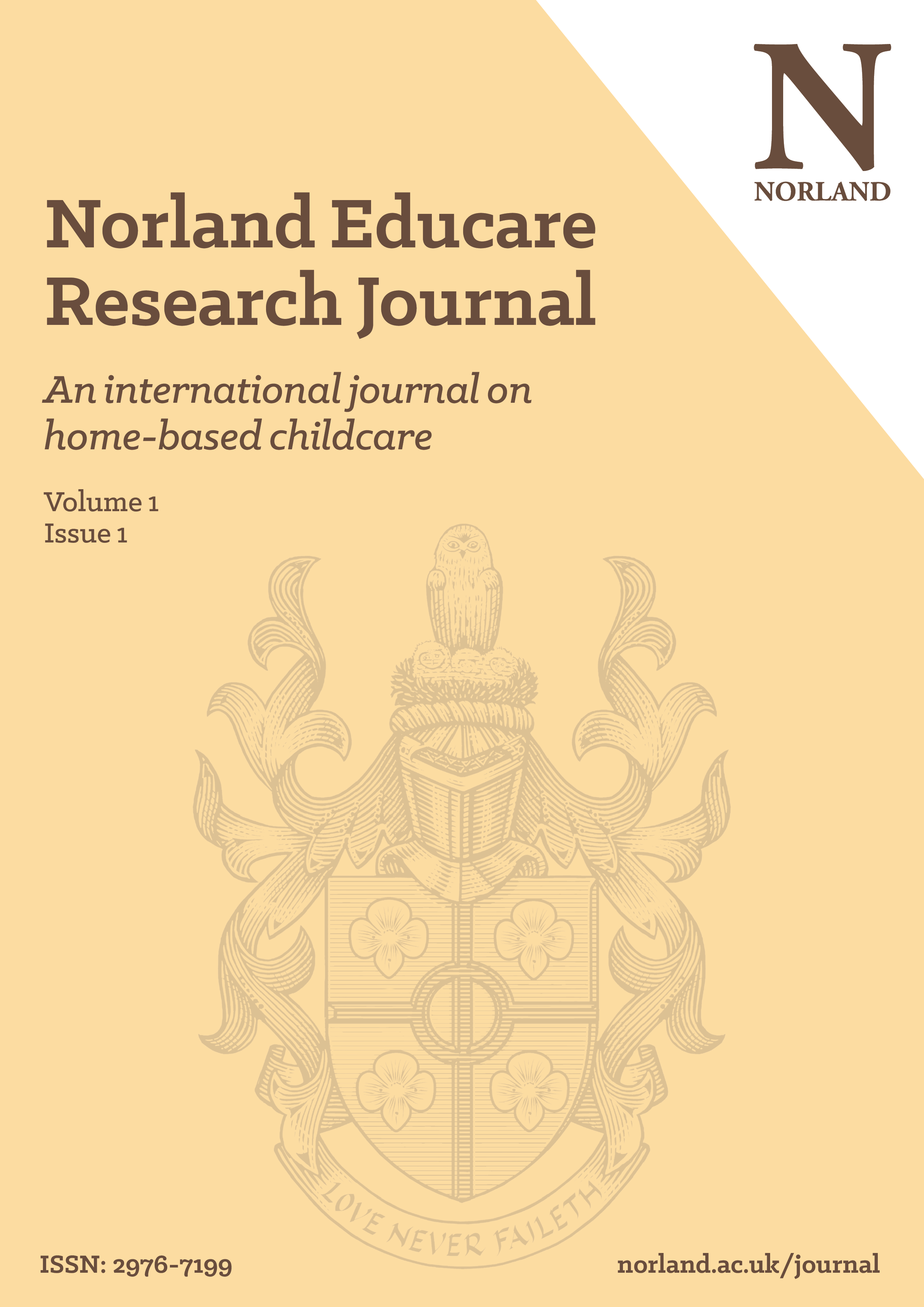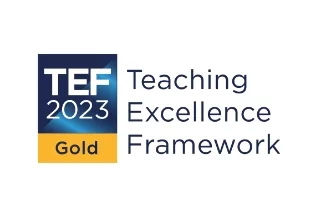Family childcare educators’ descriptions of their family-focused roles
Back to Norland Educare Research Journal
About the journal
Read more about the journalEditorial board
View our editorial boardJournal policies and ethics
View our policies and ethicsPeer review process
View peer review processInformation for readers
Read our information for readersInformation for authors
Read our information for authorsCall for papers
View our call for papersTerms and conditions
View terms and conditionsAbstract
This research highlights how family childcare educators in the United States view and navigate their work with the families of the children in their care. Although family–educator relationships can positively impact children’s learning and development and family functioning, mainstream definitions of family childcare quality often exclude or minimise these relationships. Using interview data from 26 licensed family childcare educators, I examine educators’ family-focused roles, the supports they offer to families, the strategies they use in those relationships and the challenges they face. Results illuminate the wide range of supports and resources family childcare educators offer families that can support family functioning and child development. They also reveal challenges in navigating family relationships that professional development could address.
Keywords: home-based childcare, family childcare, teacher–family relationships, family engagement
Introduction
Many families in the United States rely on home-based childcare arrangements for their young children. This is due in part to parent choice and preference, as well as challenges with centre-based childcare access (Dobbins et al., 2016; Henly and Adams, 2018).
This research focuses on one sector of home-based childcare: licensed family childcare (FCC). Although research about FCC lags behind that on centre-based early care and education settings, the evidence base is growing. The existing research documents the complexity of FCC work, the challenges that FCC educators navigate and the practices educators use to provide high-quality care (e.g., Bromer et al., 2021; Fernandez et al., 2018; Hooper, 2020).
Specifically, FCC educators often support families and children in their care in ways beyond what is typical for a classroom teacher or administrator (Bromer and Henly, 2004). This study uses interview data from licensed FCC educators to explore how they describe their family-focused roles and the supports they offer to families through these roles.
Literature review
Family childcare in the United States
In the United States, over 12 million children under 13 spend time in the care of approximately 5 million home-based childcare (HBCC) providers (Datta et al., 2021). HBCC is defined as non-parental childcare in a residential setting (NSECE Project Team, 2015).
HBCC in the United States is typically categorised as family childcare (FCC) or family, friend and neighbour care. FCC is generally defined as non-parental, paid childcare, regulated by the state, and occurring in a home (Child Care Aware of America, 2018). Definitions of FCC vary by state; regulations generally require FCC educators to be licensed once they care for a certain number of unrelated children (National Center on Early Childhood Quality Assurance, 2020).
FCC represents a critical early childhood education context because of the unique features it offers families, such as mixed-age groupings of children, continuity of care, geographic accessibility, smaller group sizes, flexible hours, affordability, a home-like environment, and a cultural and linguistic match (Liu, 2015; Vieira and Hill, 2019). Some families whose children have special needs prefer an HBCC setting for their children’s care (Hooper and Hallam, 2021). Additionally, rural children are more likely to attend HBCC than children living in suburban or urban areas (Henly and Adams, 2018). This is due, at least in part, to fewer centre-based options in rural communities and less access to transportation (Dobbins et al., 2016). FCC or other home-based care is a common caregiving choice for families who require care during non-standard hours, such as nights and weekends, when very few centre-based programmes operate (NSECE Project Team, 2015).
Educator–family relationships
The quality of the educator–family relationship is an integral part of overall early childhood programme quality. Strong educator–family relationships contribute to child and family outcomes (e.g., Sheridan et al., 2019).
Previous research has identified that strong family relationships are common in FCC. FCC educators often describe their work using family-like language, even when they are not related to the children in their care (e.g., Paredes et al., 2020). The support that FCC educators offer helps families balance work and parenting (Porter et al., 2010) and benefits families’ overall wellbeing (Kossek et al., 2008).
FCC educators provide relational and logistical supports to families (Bromer et al., 2021). Relational supports include family-like relationships (e.g., Paredes et al., 2020), trust (e.g., Ang and Tabu, 2018), reciprocal communication (e.g., Doherty, 2015) and support for family engagement in children’s learning (e.g., Larson et al., 2011). Logistical supports include flexibility (e.g., Bromer and Henly, 2009), resources and referrals to address families’ needs (e.g., Blasberg et al., 2019), and help with non-childcare tasks (e.g., Bromer and Henly, 2009).
Despite the importance of the educator–family relationship for child and family outcomes, this construct is often excluded from discussions and measures of early childhood quality (O’Regan et al., 2019). Instead, quality measures used in systems like quality rating and improvement systems (QRISs) tend to rely on structural indicators like teacher education, teacher-to-child ratios, facility features, and process indicators related to teacher–child interactions and classroom instruction (Burchinal, 2018). When quality measures include family indicators, they are often brief and surface-level, such as holding a few events per year for families.
Challenges educators may face in relationships with families
Although FCC educators tend to have strong, supportive relationships with families, they can also face challenges as they navigate their varying roles of teacher, business owner, support to parents, and more (Fernandez et al., 2018; Hooper, 2020; Gerstenblatt et al., 2014). Specifically, educators may have trouble setting boundaries with families, which can be detrimental to their business, affect their personal relationships and cause work-related stress. Therefore, FCC educators are sometimes encouraged to maintain professional boundaries. However, applying a traditional definition of professionalism to FCC might interfere with the positive support FCC educators give to families and get in the way of their close relationships, which are a strength of FCC and a reason some families select it (Bromer and Henly, 2004).
Theoretical framework
This research draws on Bronfenbrenner and Morris’s (2006) bioecological model of development. A child’s development is bidirectionally shaped by their environment, including what is most proximal to the child, and external factors. Specifically, family–educator relationships represent a mesosystem for children’s development. Bronfenbrenner (1979, p. 25) described mesosystems as “the interrelations among two or more settings in which the developing person actively participates”.
This work also uses role theory, which posits that individuals have multiple roles, defined as sets of expectations, associated with a social position, that make up their role set (Biddle, 1979). When they cannot meet perceived role demands, it can lead to role strain, such as when roles come into conflict or role expectations are unclear (Goode, 1960; Hecht, 2001). This certainly applies to FCC educators, who must adopt multiple roles within their personal and professional lives. Research has explored role challenges among FCC educators and found that their multiple roles can conflict, creating stress and challenges for educators (e.g., Fernandez et al., 2018; Gerstenblatt et al., 2014).
Current study
This research builds on previous work that focused on FCC educators’ roles (Hooper, 2020). Through semi-structured interviews, I identified a range of roles FCC educators mentioned – functional, relational and professional. Notably, many FCC educators emphasised family-related roles. This article considers the family-related roles identified in the previous study: support to families and extension of the family. Building on that research, I address two questions: 1) how do FCC educators describe their family-focused roles?, and 2) what challenges do they describe regarding family relationships?
Methods
Sample
This study was part of a larger mixed-methods study of HBCC in the US. The sample was selected from the population of listed HBCC providers in one Mid-Atlantic state who responded to a statewide survey. Licensed FCC educators and unlicensed relative care providers who received childcare subsidies were mailed a survey (n = 935). Two hundred and fifty-two responded (27% response rate).
We selected 26 FCC educators from these respondents to participate in interviews. First, educators were grouped by their characteristics from another study phase (Hooper, 2019) to ensure the interview sample represented a range of educator characteristics. Next, we drew a stratified random sample, using poverty density as a stratifying variable. The demographic characteristics of participating educators are displayed in Table 1.
Measures
Interview. I developed a semi-structured interview protocol with 12 questions and accompanying prompts. Questions related to role perception, motivation for providing care, relationships with children and families, and challenges.
Data collection procedures. Each educator selected to participate was contacted by telephone and invited to participate in the study. The lead author and a research assistant conducted all study activities. Interviews were conducted in person or over the phone. All interviews were audio-recorded and lasted from 30 to 90 minutes.
Analysis. Audio recordings of qualitative interviews were transcribed verbatim, and each participant was assigned a pseudonym. Transcripts were double-checked for accuracy and imported into NVivo 11 qualitative software for analysis. The transcripts were read and analysed separately by the primary author and a research assistant experienced in conducting research with HBCC providers. All transcripts were read without coding first to gain familiarity with each educator’s responses and begin organising key ideas.
Table 1: Descriptive statistics for demographic characteristics of participants
Variable | % |
Time licensed | |
| Up to 10 years | 38.5% |
| 10 to 20 years | 30.8% |
| More than 20 years | 30.8% |
Children enrolled | |
| Fewer than 5 | 15.4% |
| 5 to 7 | 53.8% |
| 8 or more | 30.8% |
Highest level of education | |
| High school diploma/GED | 23.1% |
| Some college credits | 46.2% |
| Associate’s degree | 11.5% |
| Bachelor’s degree or higher | 19.2% |
Educator race and ethnicity | |
| White, non-Hispanic | 53.8% |
| African American, non-Hispanic | 38.5% |
| Hispanic or Latino | 7.7% |
Transcripts were first examined using an inductive method of open coding to identify codes from participants’ responses (Corbin and Strauss, 2015), specifically focusing on the data related to how educators identified and described their roles. We followed the three procedural steps outlined by Gibbs (2007) to ensure the data were coded reliably. These steps consisted of double-checking all coded transcripts to identify any mistakes in codes, frequently comparing coded data with the original definitions for codes to avoid drift, and cross-checking coding with a second coder to ensure agreement. The coders followed an iterative process of identifying initial codes separately, discussing and defining those codes together, revising codes, and recoding transcripts. They met to discuss any differences in coding and reached a consensus. As new codes were identified, they were applied to all transcripts (Corbin and Strauss, 2015). To ensure the credibility and trustworthiness of the findings (Lincoln and Guba, 1985), we used triangulation, thick descriptions and peer debriefing.
Results
Family-focused roles
Educators identified and described two main family-focused roles: support to parents and extension of the family.
Support to parents
Participants described how they acted as a support to parents by providing information, resources and relationships.
Information. Participants described sharing community resources and helping families access those resources. Educators described posting or sending home relevant flyers, recommending parenting programmes, getting families library cards, sharing upcoming events, and making referrals. For example, one participant described partnering with the local library; she would go to the library and gather information about community resources and then share it with the families, acting as an intermediary to help families access information more easily. Participants described sharing information related to children, such as referrals for children with special needs, and resources specifically for parents. For example, one participant said: “I just like to – with the parents being young, the parents being maybe modest income, having maybe a lower education – just give them job opportunities.”
Another way educators gave informational support was by acting as a parent educator. Several participants talked about helping families navigate the transition to kindergarten and select elementary schools, including going on school visits with them. They described a variety of ways they shared educational information, such as through holding workshops based on family needs they observed, texting families tips, giving families examples of healthy meals and snacks, and modelling teaching self-help skills when parents picked up their children.
They also described helping parents understand developmental progress and milestones. For example, one participant said: “I pinpoint what’s good and I explain to the parents, because a lot of them feel as though, ‘He’s one, he should be potty-trained.’ You’re tired of buying Pampers and I get that, but all children are not the same.” They also described helping families to recognise potential health concerns in their children and raise those with doctors.
Resources. Participants also provided tangible support and resources to families. This included providing additional childcare outside their operating hours; giving financial help, such as reducing tuition, and waiving late fees or payments; and offering transportation when needed. The educators who described this kind of support said they viewed this as part of their work as an FCC educator: “Mom’s hours changed at work, so I changed my hours here for her daughter to accommodate her. I figure, we’re all in this together teaching the kids, so let’s try to continue being a unit for the kids.” Another said: “I open up at 6.30 but they need to get them here by 6.15 so I let them in. I let them in because all my parents say I am the structure in their life. I’m what they’re used to.”
When describing offering financial resources, educators often stated that this was challenging or to their detriment. One participant described lending money to families in need but then added: “Can’t tell my husband though.” Another said: “I give them money. I’m not a good business person, I don’t really make … It seems like everything I make, I give it away.” A participant described working longer hours for no pay “just because it’s the right thing to do”. Participants even talked about giving financial breaks to families even if they hadn’t asked – for example: “I knew, with their birthdays coming, they weren’t going to have a party. So I said to her, ‘I’m not taking any money this week.’”
Relationships. Finally, educators described relational roles that supported families. These included acting as a counsellor or a fill-in parent. Several used the words ‘counsellor’, ‘therapist’ and ‘mediator’ to describe their work with families. They described families confiding in them, especially staying at a pick-up time to talk. They also described negotiating conflicts between parents or among parents and grandparents.
Extension of the family
Participants talked about acting in a fill-in parent role to share some parenting responsibilities with busy parents. One educator said: “I have one dad who … He can’t keep things straight in his head, days off from school, and major homework assignments and stuff like that. I have to kind of keep up, because otherwise his seven-year-old is going to be the only one that doesn’t know.”
Educators often described serving in a role similar to that of a parent. They used phrases like “second family”, “fill-in parent”, “like the favourite aunt” and “grandma to everybody”. However, they also described how this role was distinct from and did not replace a parent’s role. For example, one educator said: “I’m like their mom. I’m not their mom. I’m not trying to take any mom’s place, but I want them to feel comfortable and secure.” In this way, HBCC educators strengthened and expanded the family support structure available to the child.
Challenges
FCC educators described experiencing and managing a range of emotions when working with families. One educator talked about working to support a family but eventually noting her need for boundaries: “I tried to help as much as I could, and then it was just involving the rest of my family … I say, ‘I have to let this family go.’ … They drain you, they drain you a lot.” Another described some of her work with families, saying: “I don’t get paid enough for it. It’s extra. I’m just doing it out of the kindness of my heart.”
Educators talked about pushing through difficult emotions and exhaustion in their work with families, primarily for the child’s benefit. Despite these educators’ focus on the child, such challenges clearly took a toll on them: “It’s hard though. Yeah, in the meantime, she still has these issues. It’s hard to see somebody go through all of that, and then he’s repeating it, the child repeats it. So that’s tough.” Together, FCC educators seemed to face challenges establishing and maintaining boundaries and managing emotions in their work with families.
Discussion
This research builds on and adds to the evidence that shows the vital role FCC educators play in supporting families. Specifically, they offer informational support, resources and relationships to families and act as an extension of the family in ways that seem to benefit both the child/children and their family. This is an essential component of quality that is often under-recognised and undervalued in traditional quality measures (Kagan and Kauerz, 2015).
However, there was evidence in educators’ responses that navigating their family-focused roles could be challenging and emotionally complex, especially when they saw families experiencing hardship and when that affected the child. FCC educators would likely benefit from additional opportunities and support for establishing healthy relationships with families (Bromer and Henly, 2009).
The participants clearly valued their relationships with families, even when they described doing things they identified as non-traditional or that others may view negatively, such as supporting families financially or offering childcare outside their regular hours (Paredes et al., 2020). Therefore, a typical notion of ‘professional relationships’ is likely not the best fit for FCC educators (O’Regan et al., 2019).
FCC educators’ close relationships with families are a strength of FCC. However, they could lead to burnout or challenges in educators’ personal relationships if not navigated carefully. Therefore, future work could consider ways to support this unique and valuable strength of FCC while helping to ensure it does not come at the expense of an educator’s health or wellbeing.
This research only includes licensed FCC educators in one US state. Therefore, findings may not generalise outside of this content. However, they point to an area for further exploration and recognition: the close, supportive relationships between FCC educators and the families they serve.
Finding ways to include these close relationships in quality definitions is essential as the field seeks to measure quality and equitably recognise the diversity of early childhood education settings (Souto-Manning and Rabadi-Raol, 2018). Currently, most quality standards do not capture the meaningful relationships and supports FCC educators offer to families (Melvin, 2022), which are an essential and under-recognised component of quality. Elevating this aspect of FCC is critical to recognising the work FCC educators do and ensuring they have the support to continue to serve families in sustainable ways.
Acknowledgements
The project described was supported by the OPRE Child Care Research Scholars Dissertation Grant, Grant Number 90YE0160, from the Office of Planning, Research and Evaluation, Administration for Children and Families, US Department of Health and Human Services.
Declaration of authorship and conflict-of-interest statement
The author confirms that this is their own work and there are no known conflicts of interest, financial or non-financial, associated with this publication.
References
Ang, L. and Tabu, M. (2018) ‘Conceptualising home-based child care: a study of home-based settings and practices in Japan and England’, International Journal of Early Childhood, 50(2), pp. 143–158.
Biddle, B. J. (1979) Role theory: expectations, identities, and behaviors. New York: Academic Press.
Blasberg, A., Bromer, J., Nugent, C., Porter, T., Shivers, E. M., Tonyan, H., Tout, K. and Weber, B. (2019) A conceptual model for quality in home-based child care. OPRE Report #2019-37. Washington, DC: Office of Planning, Research, and Evaluation, Administration for Children and Families, US Department of Health and Human Services.
Bromer, J. and Henly, J. R. (2004) ‘Child care as family support: caregiving practices across child care providers’, Children and Youth Services Review, 26(10), pp. 941–964.
Bromer, J. and Henly, J. R. (2009) ‘The work–family support roles of child care providers across settings’, Early Childhood Research Quarterly, 24(3), pp. 271–288.
Bromer, J., Porter, T., Jones, C., Ragonese-Barnes, M. and Orland, J. (2021) Quality in home-based child care: a review of selected literature. OPRE Report #2021-136. Washington, DC: Office of Planning, Research, and Evaluation, Administration for Children and Families, US Department of Health and Human Services. Available at: https://www.acf.hhs.gov/opre/report/quality-home-based-child-care-review-selected-literature (Accessed: 23 September 2022).
Bronfenbrenner, U. (1979) The ecology of human development: experiments by nature and design. Cambridge, MA: Harvard University Press.
Bronfenbrenner, U. and Morris, P. A. (2006) ‘The bioecological model of human development’, in R. M. Lerner and W. Damon (eds) Handbook of child psychology: theoretical models of human development. New York: Wiley, pp. 793–828.
Burchinal, M. (2018) ‘Measuring early care and education quality’, Child Development Perspectives, 12(1), pp. 3–9.
Child Care Aware of America (CCAA) (2018) Family child care providers. Available at: https://www.childcareaware.org/wp-content/uploads/2018/11/FCC-Resources.pdf (Accessed: 23 September 2022).
Corbin, J. and Strauss, A. (2015) Basics of qualitative research. Thousand Oaks, CA: Sage.
Datta, A. R., Milesi, C., Srivastava, S. and Zapata-Gietl, C. (2021) Home-based early care and education providers in 2012 and 2019: counts and characteristics. OPRE Report #2021-85. Washington, DC: Office of Planning, Research and Evaluation, Administration for Children and Families, US Department of Health and Human Services. Available at: https://www.acf.hhs.gov/opre/report/home-based-early-care-and-education-providers-2012-and-2019-counts-and-characteristics (Accessed: 22 September 2022).
Dobbins, D., Tercha, J., McCready, M. and Liu, A. (2016) Child care deserts: developing solutions to child care supply and demand. Child Care Aware of America. Available at: https://www.childcareaware.org/wp-content/uploads/2016/09/Child-Care-Deserts-report-FINAL2.pdf (Accessed: 23 September 2022).
Doherty, G. (2015) ‘Quality in family child care: a focus group study with Canadian providers’, Early Childhood Education Journal, 43(3), pp. 157–167.
Fernandez, J., Mootoo, C. J., Romero, S. and Rasmussen, A. (2018) ‘Role conflict among family childcare providers in the Bronx’, Children & Society, 32(6), pp. 470–480.
Gerstenblatt, P., Faulkner, M., Lee, A. A., Doan, L. and Travis, D. (2014) ‘Not babysitting: work stress and well-being for family child care providers’, Early Childhood Education Journal, 42(1), pp. 67–75.
Gibbs, G. R. (2007) Analyzing qualitative data. Thousand Oaks, CA: Sage.
Goode, W. J. (1960) ‘A theory of role strain’, American Sociological Review, 25(4), pp. 483–496.
Hecht, L. M. (2001) ‘Role conflict and role overload: different concepts, different consequences’, Sociological Inquiry, 71(1), pp. 111–121.
Henly, J. R. and Adams, G. (2018) Increasing access to quality child care for four priority populations: challenges and opportunities with CCDBG reauthorization. Urban Institute. Available at: https://www.urban.org/research/publication/increasing-access-quality-child-care-four-priority-populations (Accessed: 22 September 2022).
Hooper, A. (2019) ‘Classifying home-based child care providers: validating a typology of providers’ beliefs and self-reported practices’, Early Childhood Education Journal, 47(3), pp. 275–285.
Hooper, A. (2020) ‘“I’m a teacher, unofficially”: how home-based providers perceive and navigate their roles’, Journal of Research in Childhood Education, 34(2), pp. 223–237.
Hooper, A. and Hallam, R. (2019) ‘Identifying profiles of listed home-based child care providers based on their beliefs and self-reported practices’, Early Childhood Research Quarterly, 47(2), pp. 194–205.
Hooper, A. and Hallam, R. (2021) ‘Prevalence and characteristics of home-based child care providers serving children with provider-reported disabilities’, Journal of Early Intervention, 43(2), pp. 135–154.
Kagan, L. and Kauerz, K. (eds) (2015) Early childhood systems: transforming early learning. Teachers College Press.
Kossek, E. E., Pichler, S. M., Meece, D. and Barratt, M. E. (2008) ‘Family, friend, and neighbour child care providers and maternal well‐being in low‐income systems: an ecological social perspective’, Journal of Occupational and Organizational Psychology, 81(3), pp. 369–391.
Larson, N., Ward, D., Neelon, S. B. and Story, M. (2011) Preventing obesity among preschool children: how can child-care settings promote healthy eating and physical activity? Research Synthesis. Robert Wood Johnson Foundation. Available at: https://healthyeatingresearch.org/wp-content/uploads/2013/12/RS_ChildCare_FINAL-10-27-11.pdf (Accessed: 21 September 2022).
Lincoln, Y. S. and Guba, E. G. (1985) Naturalistic inquiry. Beverly Hills, CA: Sage.
Liu, M. (2015) ‘An ecological review of literature on factors influencing working mothers’ child care arrangements’, Journal of Child and Family Studies, 24(1), pp. 161–171.
Melvin, S. (2022) Reconceptualizing quality in family child care: unpacking provider perceptions of quality and their implications for alignment and engagement with quality rating and improvement systems. PhD thesis. Columbia University.
National Center on Early Childhood Quality Assurance (2020) Trends in family child care home licensing requirements and policies for 2017. Research Brief #2. Available at: https://childcareta.acf.hhs.gov/sites/default/files/public/2003_fcch_licensing_trends_brief_2017_final_0.pdf (Accessed: 23 September 2022).
NSECE Project Team (2015) Fact sheet: Who is providing home-based early care and education? OPRE Report #2015-43. Available at: https://www.acf.hhs.gov/opre/report/fact-sheet-who-providing-home-based-early-care-and-education (Accessed: 23 September 2022).
O’Regan, M., Halpenny, A. M. and Hayes, N. (2019) ‘Childminding in Ireland: attitudes towards professionalisation’, European Early Childhood Education Research Journal, 27(6), pp. 757–775.
Paredes, E., Hernandez, E., Herrera, A. and Tonyan, H. (2020) ‘Putting the “family” in family child care: the alignment between familismo (familism) and family child care providers’ descriptions of their work’, Early Childhood Research Quarterly, 52, pp. 74–85.
Porter, T., Paulsell, D., Del Grosso, P., Avellar, S., Hass, R. and Vuong, L. (2010) A review of the literature on home-based child care: implications for future directions. Mathematica Policy Research. Available at: https://www.acf.hhs.gov/opre/report/review-literature-home-based-child-care-implications-future-directions-final (Accessed: 23 September 2022).
Sheridan, S. M., Smith, T. E., Moorman Kim, E., Beretvas, S. N. and Park, S. (2019) ‘A meta-analysis of family-school interventions and children’s social-emotional functioning: moderators and components of efficacy’, Review of Educational Research, 89(2), pp. 296–332.
Souto-Manning, M. and Rabadi-Raol, A. (2018) ‘(Re)Centering quality in early childhood education: toward intersectional justice for minoritized children’, Review of Research in Education, 42(1), pp. 203–225.
Vieira, N. and Hill, S. (2019) Creating the conditions for family child care to thrive: strategies for increasing the supply, quality, and sustainability of family child care in states and communities. All Our Kin. Available at: https://allourkin.org/files/galleries/Family_Child_Care_to_Thrive.pdf (Accessed: 23 September 2022).
Related articles
Front matter and content page: Norland Educare Research Journal
The Norland Educare Research Journal is an international double-blind peer-reviewed journal, published annually, online only. It is an open access journal, offering free-of-charge publication to researchers and authors, and free...
Editorial – Home-based educarers: powerful agents who cannot be neglected!
Home-based childcare, in the form of childminding and nannying, is a vital service to families (Ang et al., 2017). It is mainly used by families, such as those in rural...
Useful links and information for the Norland Educare Research Journal
About the journal
Read more about the journalEditorial board
View our editorial boardJournal policies and ethics
View journal policies and ethicsInformation for readers
View information for readersInformation for authors
View information for authorsCall for papers
View call for papersTerms and conditions
View terms and conditions



Translate this page